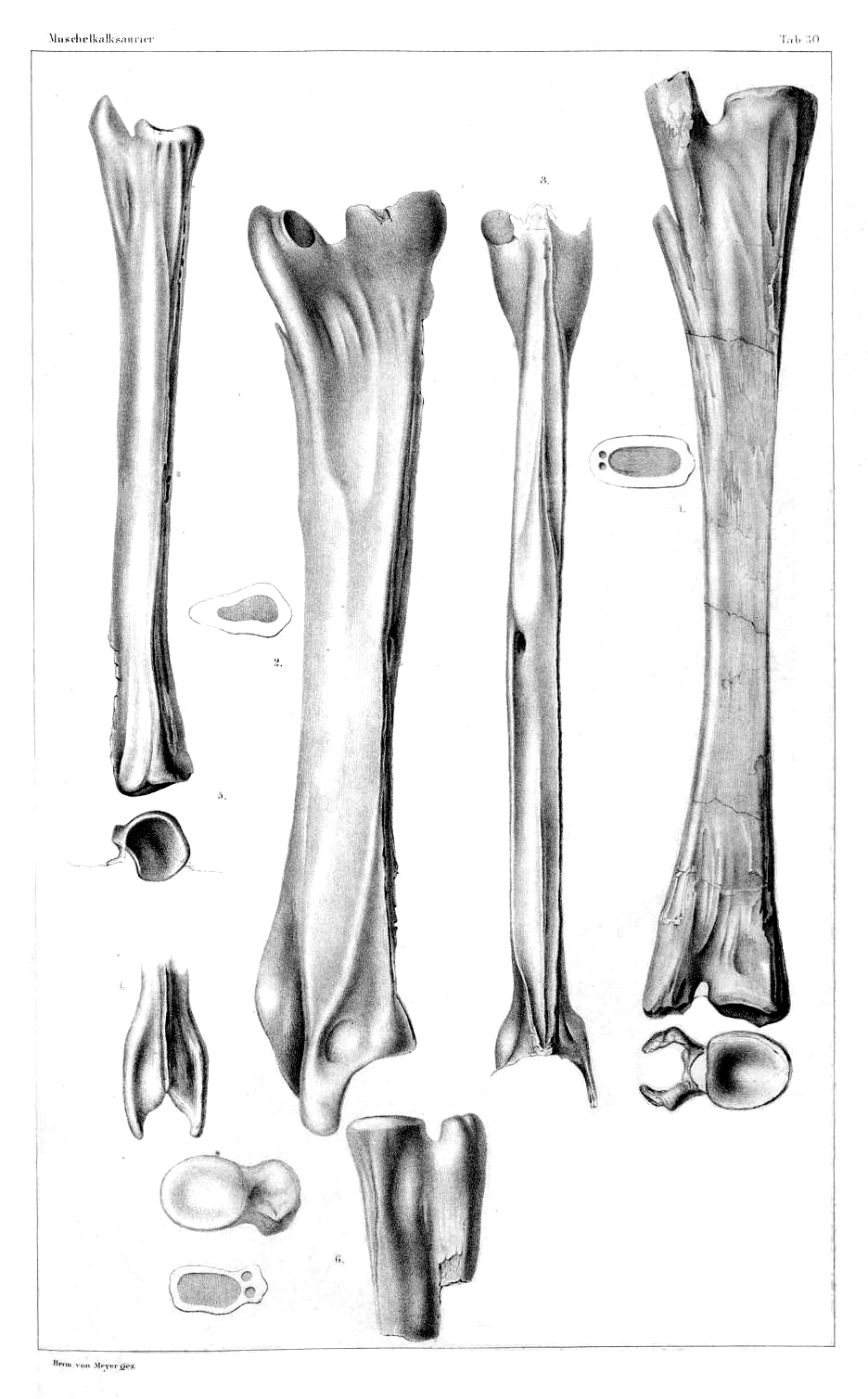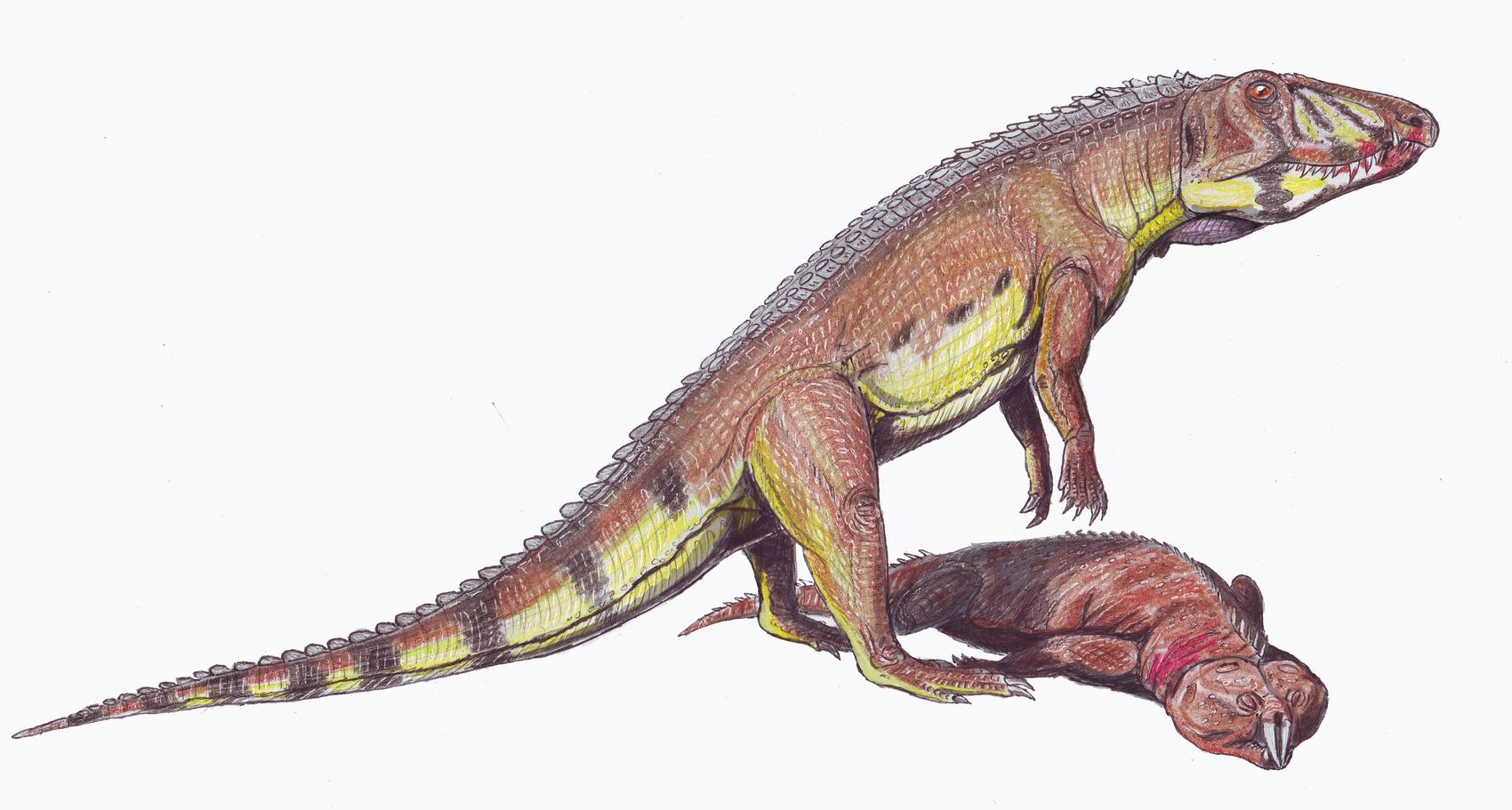|
Allokotosauria
Allokotosauria is a clade of early archosauromorph reptiles from the Middle to Late Triassic known from Asia, Africa, North America and Europe. Allokotosauria was first described and named when a new monophyletic grouping of specialized herbivorous archosauromorphs was recovered by Sterling J. Nesbitt, John J. Flynn, Adam C. Pritchard, J. Michael Parrish, Lovasoa Ranivoharimanana and André R. Wyss in 2015. The name Allokotosauria is derived from Greek meaning "strange reptiles" in reference to unexpected grouping of early archosauromorph with a high disparity of features typically associated with herbivory. History Nesbitt ''et al.'' (2015) defined the group as a stem-based taxon containing '' Azendohsaurus madagaskarensis'' and '' Trilophosaurus buettneri'' and all taxa more closely related to them than to ''Tanystropheus longobardicus'', '' Proterosuchus fergusi'', ''Protorosaurus speneri'' or '' Rhynchosaurus articeps''. Therefore, Allokotosauria includes the families Aze ... [...More Info...] [...Related Items...] OR: [Wikipedia] [Google] [Baidu] |
Azendohsaurus Madagaskarensis
''Azendohsaurus'' is an extinct genus of herbivorous archosauromorph reptile from roughly the late Middle to early Late Triassic Period of Morocco and Madagascar. The type species, ''Azendohsaurus laaroussii'', was described and named by Jean-Michel Dutuit in 1972 based on partial jaw fragments and some teeth from Morocco. A second species from Madagascar, ''A. madagaskarensis'', was first described in 2010 by John J. Flynn and colleagues from a multitude of specimens representing almost the entire skeleton. The generic name "Azendoh lizard" is for the village of Azendoh, a local village near where it was first discovered in the Atlas Mountains. It was a bulky quadruped that unlike other early archosauromorphs had a relatively short tail and robust limbs that were held in an odd mix of sprawled hind limbs and raised forelimbs. It had a long neck and a proportionately small head with remarkably sauropod-like jaws and teeth. ''Azendohsaurus'' used to be classified as a herbivorous ... [...More Info...] [...Related Items...] OR: [Wikipedia] [Google] [Baidu] |
Azendohsaurus
''Azendohsaurus'' is an extinct genus of Herbivore, herbivorous archosauromorph reptile from roughly the late Middle Triassic, Middle to early Late Triassic, Late Triassic Period of Morocco and Madagascar. The type species, ''Azendohsaurus laaroussii'', was described and named by Jean-Michel Dutuit in 1972 in paleontology, 1972 based on partial jaw fragments and some teeth from Morocco. A second species from Madagascar, ''A. madagaskarensis'', was first described in 2010 in paleontology, 2010 by John J. Flynn and colleagues from a multitude of specimens representing almost the entire skeleton. The Generic name (biology), generic name "Azendoh lizard" is for the village of Azendoh, a local village near where it was first discovered in the Atlas Mountains. It was a bulky quadruped that unlike other early archosauromorphs had a relatively short tail and robust limbs that were held in an odd mix of sprawled hind limbs and raised forelimbs. It had a long neck and a proportionately small ... [...More Info...] [...Related Items...] OR: [Wikipedia] [Google] [Baidu] |
Azendohsauridae
Azendohsauridae is a family of allokotosaurian archosauromorphs that lived during the Middle to Late Triassic period, around 242-216 million years ago. The family was originally named solely for the eponymous ''Azendohsaurus'', marking out its distinctiveness from other allokotosaurs, but the family now includes four other genera: the basal genus '' Pamelaria'', the large horned herbivore '' Shringasaurus'', and two carnivorous genera grouped into the subfamily-level subclade Malerisaurinae, ''Malerisaurus'' and ''Puercosuchus'', and potentially also the dubious genus ''Otischalkia''. Most fossils of azendohsaurids have a Gondwanan distribution, with multiple species known across Morocco and Madagascar in Africa as well as India, although fossils of malerisaurine azendohsaurids have also been found in the southwestern United States of North America. Azendohsaurids are notable for the various dinosaur-like traits found in some species, including the sauropodomorph-like neck, jaw ... [...More Info...] [...Related Items...] OR: [Wikipedia] [Google] [Baidu] |
Tanystropheus Longobardicus
''Tanystropheus'' (~ 'long' + 'hinged') is an extinct genus of archosauromorph reptile which lived during the Triassic period, Triassic Period in Europe, Asia, and North America. It is recognisable by its extremely elongated neck, longer than the torso and tail combined. The neck was composed of 13 vertebrae strengthened by extensive cervical ribs. ''Tanystropheus'' is one of the most well-described non-Archosauriformes, archosauriform archosauromorphs, known from numerous fossils, including nearly complete skeletons. Some species within the genus may have reached a total length of , making ''Tanystropheus'' the longest non-archosauriform archosauromorph as well. ''Tanystropheus'' is the namesake of the family Tanystropheidae, a clade collecting many long-necked Triassic archosauromorphs previously described as "Protorosauria, protorosaurs" or "Prolacertiformes, prolacertiforms". ''Tanystropheus'' contains at least two valid species as well as fossils which cannot be referred to ... [...More Info...] [...Related Items...] OR: [Wikipedia] [Google] [Baidu] |
Archosauromorph
Archosauromorpha (Greek for "ruling lizard forms") is a clade of diapsid reptiles containing all reptiles more closely related to archosaurs (such as crocodilians and dinosaurs, including birds) than to lepidosaurs (such as tuataras, lizards, and snakes). Archosauromorphs first appeared during the late Middle Permian or Late Permian, though they became much more common and diverse during the Triassic period. Although Archosauromorpha was first named in 1946, its membership did not become well-established until the 1980s. Currently Archosauromorpha encompasses four main groups of reptiles: the stocky, herbivorous allokotosaurs and rhynchosaurs, the hugely diverse Archosauriformes, and a polyphyletic grouping of various long-necked reptiles including '' Protorosaurus'', tanystropheids, and '' Prolacerta''. Other groups including pantestudines (turtles and their extinct relatives) and the semiaquatic choristoderes have also been placed in Archosauromorpha by some authors. Ar ... [...More Info...] [...Related Items...] OR: [Wikipedia] [Google] [Baidu] |
Trilophosaurus Buettneri
''Trilophosaurus'' (Greek for "lizard with three ridges") is a lizard-like trilophosaurid allokotosaur known from the Late Triassic of North America. It was a herbivore up to 2.5 m long. Description ''Trilophosaurus'' had a short, unusually heavily built skull, equipped with massive, broad flattened cheek teeth with sharp shearing surfaces for cutting up tough plant material. Teeth are absent from the premaxilla and front of the lower jaw, which in life were probably equipped with a horny beak. Based on evidence derived from tooth wear patterns, ''Trilophosaurus'' was able to masticate labiolingually. The skull is also unusual in that the lower temporal opening is missing, giving the appearance of a euryapsid skull. Because of this, the trilophosaurs were once classified with placodonts within Sauropterygia. Carroll (1988) suggested that the lower opening may have been lost to strengthen the skull. Taxonomy ''Trilophosaurus'' is traditionally thought to include two val ... [...More Info...] [...Related Items...] OR: [Wikipedia] [Google] [Baidu] |
Pamelaria
''Pamelaria'' is an extinct genus of allokotosaurian archosauromorph reptile known from a single species, ''Pamelaria dolichotrachela'', from the Middle Triassic of India. ''Pamelaria'' has sprawling legs, a long neck, and a pointed skull with nostrils positioned at the very tip of the snout. Among early archosauromorphs, ''Pamelaria'' is most similar to '' Prolacerta'' from the Early Triassic of South Africa and Antarctica. Both have been placed in the family Prolacertidae. ''Pamelaria'', ''Prolacerta'', and various other Permo-Triassic reptiles such as ''Protorosaurus'' and ''Tanystropheus'' have often been placed in a group of archosauromorphs called Protorosauria (alternatively called Prolacertiformes), which was regarded as one of the most basal group of archosauromorphs. However, more recent phylogenetic analyses indicate that ''Pamelaria'' and ''Prolacerta'' are more closely related to Archosauriformes than are ''Protorosaurus'', ''Tanystropheus'', and other protorosaurs, ... [...More Info...] [...Related Items...] OR: [Wikipedia] [Google] [Baidu] |
Trilophosauridae
Trilophosaurs are lizard-like Triassic allokotosaur reptiles related to the archosaurs. The best known genus is '' Trilophosaurus'', a herbivore up to long. It had a short, unusually heavily built skull, equipped with massive, broad flattened cheek teeth with sharp shearing surfaces for cutting up tough plant material. Teeth are absent from the premaxilla and front of the lower jaw, which in life were probably equipped with a horny beak. The skull is also unusual in that the lower temporal opening is missing, giving the appearance of a euryapsid skull, and originally the Trilophosaurs were classified with placodonts and sauropterygia. Carroll (1988) suggests that the lower opening may have been lost to strengthen the skull. Trilophosaurs are so far known only from the Late Triassic of North America and Europe. Below is a cladogram A cladogram (from Greek language, Greek ''clados'' "branch" and ''gramma'' "character") is a diagram used in cladistics to show relatio ... [...More Info...] [...Related Items...] OR: [Wikipedia] [Google] [Baidu] |
Cryptovaranoides
''Cryptovaranoides'' ("hidden lizard-like animal") is an extinct genus of reptile from the Late Triassic Magnesian Conglomerate of England. It contains a single species, ''Cryptovaranoides microlanius''. Discovery and naming It is represented by a holotype partial skeleton as well as referred isolated bones from Rhaetian-aged fissure fill-deposits in Slickstones Quarry, near Tortworth, Gloucestershire preserved alongside the common fossil rhynchocephalian ''Clevosaurus''. The type specimen had been collected in 1953, but was only described as a distinct taxon in 2022. Classification When first described, ''Cryptovaranoides'' was interpreted as a crown group squamate belonging to the clade Anguimorpha, based on features of the skull architecture, braincase, dentition and postcranium. Since fossils of crown-squamates otherwise are known only from the Middle Jurassic onwards, ''Cryptovaranoides'' would push back the estimated origin of modern squamates by 35 million years, i ... [...More Info...] [...Related Items...] OR: [Wikipedia] [Google] [Baidu] |
Reptile
Reptiles, as commonly defined, are a group of tetrapods with an ectothermic metabolism and Amniotic egg, amniotic development. Living traditional reptiles comprise four Order (biology), orders: Testudines, Crocodilia, Squamata, and Rhynchocephalia. About 12,000 living species of reptiles are listed in the Reptile Database. The study of the traditional reptile orders, customarily in combination with the study of modern amphibians, is called herpetology. Reptiles have been subject to several conflicting Taxonomy, taxonomic definitions. In Linnaean taxonomy, reptiles are gathered together under the Class (biology), class Reptilia ( ), which corresponds to common usage. Modern Cladistics, cladistic taxonomy regards that group as Paraphyly, paraphyletic, since Genetics, genetic and Paleontology, paleontological evidence has determined that birds (class Aves), as members of Dinosauria, are more closely related to living crocodilians than to other reptiles, and are thus nested among re ... [...More Info...] [...Related Items...] OR: [Wikipedia] [Google] [Baidu] |
Protorosaurus Speneri
''Protorosaurus'' (from , 'earlier' and , 'lizard') is an extinct genus of reptile. Members of the genus lived during the late Permian period in what is now Germany and Great Britain. Once believed to have been an ancestor to lizards, ''Protorosaurus'' is now known to be one of the oldest and most primitive members of Archosauromorpha, the group that would eventually lead to archosaurs such as crocodilians and dinosaurs. Description ''Protorosaurus'' grew up to in length, and was a slender, lizard-like animal, vaguely resembling a monitor lizard, with long legs and a long neck. History ''Protorosaurus'' was one of the first fossil reptiles to be described, being initially described in Latin in 1710 by from a specimen found in Thuringia in Germany, who considered the animal to be a crocodile, and most similar to the Nile crocodile (''C. niloticus''). Over a century later, in publications in 1830 and 1832 Christian Erich Hermann von Meyer, Hermann von Meyer recognised ''Pr ... [...More Info...] [...Related Items...] OR: [Wikipedia] [Google] [Baidu] |
Proterosuchus Fergusi
''Proterosuchus'' is an extinct genus of archosauriform reptiles that lived during the Early Triassic. It contains three valid species: the type species ''P. fergusi'' and the referred species ''P. alexanderi'' and ''P. goweri''. All three species lived in what is now South Africa. The genus was named in 1903 by the South African paleontologist Robert Broom. The genus ''Chasmatosaurus'' is a junior synonym of ''Proterosuchus''. ''Proterosuchus'' was a mid-sized quadrupedal reptile with a sprawling stance that could reach a length of up to . It had a large head and distinctively hooked snout. It was a predator, which may have hunted prey such as ''Lystrosaurus''. The lifestyle of ''Proterosuchus'' remains debated; it may have been terrestrial or it may have been a semiaquatic ambush predator similar to modern crocodiles. ''Proterosuchus'' is one of the earliest members of the clade Archosauriformes, which also includes crocodilians, pterosaurs, and dinosaurs, including birds. It ... [...More Info...] [...Related Items...] OR: [Wikipedia] [Google] [Baidu] |





